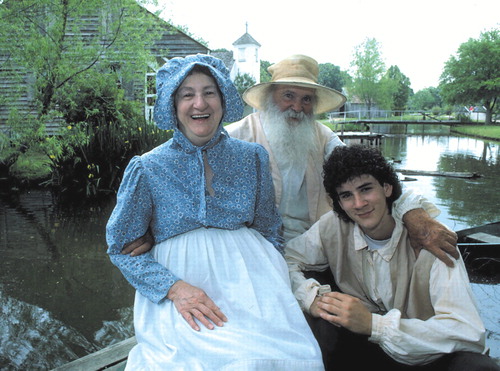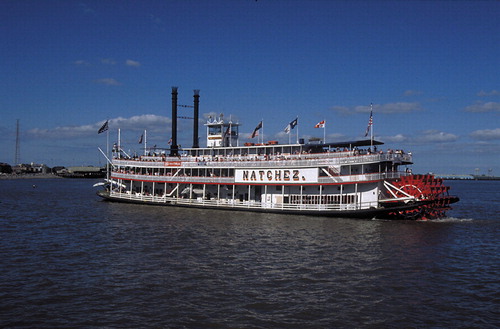Leave New Orleans and Discover ‘Real’ Louisiana
 For the person of real discipline who’s able to say “No” to another deep-fried beignet and really wants to see the region around New Orleans, there’s a whole bunch of interesting things to do. Here’s a selection.
For the person of real discipline who’s able to say “No” to another deep-fried beignet and really wants to see the region around New Orleans, there’s a whole bunch of interesting things to do. Here’s a selection.
The statue of General Andrew Jackson may dominate Jackson Square, but he and his men fought their battle several miles away, and you can visit the site. Reached either by riverboat cruise (ships leave from near the French Quarter) or by car, the Chalmette National Battlefield in east New Orleans preserves the site of the Battle of New Orleans. The lovely site today on the Mississippi River belies its bloody history. This decisive victory of the somewhat rag-tag American army over the British in the War of 1812 was actually fought after a truce had been declared. But slow communication delayed the word, and Jackson and his stalwarts stopped the British at this historic spot. Facilities include a visitors’ center.
By the way, the National Park Service, which runs the site, also has a visitors’ center in the French Quarter at 419 Decatur Street. From this center, excellent walking tours are conducted by Park Service personnel to give “an overview of the natural and historical resources of the Mississippi Delta region interpreting its unique cultural diversity.”
New Orleans’ cemeteries attract a great many visitors for the splendor and beauty of the monuments for the aboveground burial vaults. An outlying cemetery, the Lake Lawn Metairie Cemetery, however, can be appreciated without being concerned about crime, which has unfortunately invaded several of the other notable cemeteries. Nearby is Longue Vue House and Gardens, both house and gardens simply beautiful and well worth this trip some distance from downtown. The mansion in the Classical Revival style is surrounded by eight acres of gardens laid out to complement a lovely Spanish courtyard. There’s also a hands-on, interactive Discovery Garden for children.
Plantation Visits
Plantations, and the system of slavery upon which their existence depended, were an integral part of the economic and social life of New Orleans, and some can still be seen today. Most lie generally in the 60 miles between New Orleans and Baton Rouge, but several are quite close to New Orleans and can be easily reached.
The closest is the oldest of them all, Destrehan Plantation, eight miles west of the New Orleans airport. Built in 1787 in French Colonial style, it was later modified into Greek Revival style and is reputed to be haunted. (Actually, lots of places are said to be haunted in New Orleans.) It is the oldest documented plantation house still intact in the lower Mississippi Valley. Hand-hewn cypress timbers and a West Indies–style roof are unique features of the house, set among live oaks on beautiful grounds.
Nearby is another interesting place that is also a bit bizarre. San Francisco House got its name from the lament of its builder that the cost of construction had left him “sans frusquin,” or “without a penny.” This was later somehow corrupted into “San Francisco.” The name is not the only unusual thing about the place, an amazing Gothic Creole home, also referred to as “Steamboat Gothic,” with highly elaborate wood carving and painted walls, ceiling frescos, and elaborate decoration within and without.
Probably the most interesting of the plantations further away from the city are Nottoway Plantation, Houmas House, and Oak Alley. They can be reached by car or through tour operators. Nottoway, a Greek Revival and Italianate mansion, is the largest plantation home in the South, at more than 53,000 square feet. Completed in 1859, it was originally surrounded by more than 7,000 acres of land devoted to sugarcane cultivation and was virtually unique in having hot and cold running water and a gas lighting system. Houmas House, built in 1840, is also a Greek Revival house, with spacious and lovely grounds that originally extended for 10,000 acres. It’s a stunning place, the setting for Bette Davis’s movie, “Hush, Hush, Sweet Charlotte,” and a favorite for visitors.
Oak Alley has the distinction of an approach that is pure Hollywood. Sometime in the 1700s, a settler built a small house on the site of the present mansion and planted 28 oak trees in two rows reaching from his house to the Mississippi River. They’re still there, and as one looks at the later, 1839 mansion through the alley of trees, the view is one that has come to be associated with the Old South.

A visitor to any of these plantations might just as well continue on to Louisiana’s capital city, Baton Rouge. It is a more modest and staid city than New Orleans, but what city isn’t? Baton Rouge offers a number of interesting nearby plantations, art galleries, and public buildings. The skyscraper state capitol dominates the landscape and, for the history buff, is famous as the site of Huey Long’s assassination.
Cajun Country
Most people rightly associate New Orleans with Cajun and Creole cuisines and therefore are surprised to find that it does not lie in Cajun country. Cajun life centers around the city of Lafayette, which is about a two-hour drive to the west of New Orleans.
Lafayette boasts the Acadian Village, a recreation of a 19th-century Cajun settlement, good restaurants with authentic and frequently fiery Cajun food, and scores of other attractions. In New Iberia, you can tour Shadows on the Teche, a plantation property managed by the National Trust for Historic Preservation. Nearby is St. Martinsville, considered the Cajuns’ ancestral home, and Avery Island, home of the Tabasco Pepper Sauce Factory. You’ll see lots of that pepper sauce in New Orleans’ restaurants, by the way. ▪



